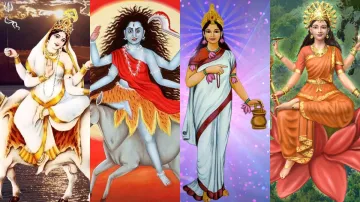Navratri kickstarts on October 3, know which goddess to worship on which day during 9-day festival
Embark on a spiritual journey! Know about the nine goddesses worshipped during Navratri, their significance, and rituals to observe for a blessed and auspicious celebration.

Sharadiya Navratri begins today, October 3. The festival of Navratri is celebrated for a full 9 days. During this, nine different forms of Maa Durga are worshiped. Every year Sharadiya Navratri starts from the Pratipada date of Shukla Paksha of Ashwin month. Autumn season starts in the month of Ashwin itself, hence it is also called Sharadiya Navratri. This time Navratri will conclude on 12th October with Vijayadashami. Durga Mata will be bid farewell on this day. So let us now know which goddess will be worshiped on which day for the nine days of Navratri.
1. First day of Navratri - Maa Shailputri
On the first day of Navratri, Goddess Shailputri is worshipped. This form of Goddess Durga is called Shailputri because she was born as the daughter of Parvataraja Himalaya. Goddess Shailputri has a trident in her right hand and a lotus flower in her left hand. Goddess Shailputri rides a bull. This form of Goddess Shailputri is extremely divine and charming. According to beliefs, worshipping Goddess Shailputri removes the bad effects of the moon.
2. Second day of Navratri - Maa Brahmacharini
Mother Brahmacharini is worshipped on the second day of Navratri. Mother Brahmacharini is dressed in white clothes and has a rosary in her right hand and a kamandalu in her left hand. Anyone who worships Mother Brahmacharini can gain the power to win in any field of life. This also increases the morale of a person to work hard, patience, and restraint.
3. Third day of Navratri - Maa Chandraghanta
On the third day of Navratri, the third form of Maa Durga, Maa Chandraghanta is worshipped. The Goddess is known as Chandraghanta because a bell-shaped half-moon adorns her forehead. Maa Chandraghanta, whose vehicle is a lion, has a lotus flower, bow, jaap mala, and arrow in her four right hands out of ten hands. The fifth hand is in abhaya mudra, while the four left hands hold a trident, mace, kamandal, and sword and the fifth hand is in varada mudra. Maa Chandraghanta is always ready to protect her devotees. Even the biggest enemy cannot stand before the sound of her bell.
4. Fourth day of Navratri - Maa Kushmanda
On the fourth day of Navratri, there is a ritual of worshipping Goddess Kushmanda. Since the Goddess has eight arms, she is also called Ashtabhuja Wali. In the seven hands of Goddess Kushmanda, one can see Kamandalu, bow, arrow, lotus, a vessel filled with nectar, chakra, and mace, while in the eighth hand, one holds a rosary. The vehicle of Goddess Kushmanda is a lion. Worshiping Goddess Kushmanda increases fame, strength, and age. Along with this, happiness and prosperity remain in the family.
5. Fifth day of Navratri - Maa Skandmata
On the fifth day of Navratri, it is customary to worship Skandamata, the fifth form of Maa Durga. Devi Maa is called Skandamata because she is the mother of Skanda Kumar, i.e. Kartikeya, who is called the commander of the gods. Skandamata has four arms. She is holding her son Skanda in her upper right arm and her lower right hand and one left-hand holds a lotus flower, while the other left hand of the mother is in Abhaya Mudra. It is believed that Devi Maa showers her blessings on her devotees in the same way as a mother showers her blessings on her children. Devi Maa bestows happiness, peace, and prosperity on her devotees.
6. Sixth day of Navratri - Maa Katyayani
This form of Maa Durga is extremely divine. Maa Katyay's colour is as bright as gold. Out of her four arms, she has a sword in her upper left hand and a lotus flower in her lower left hand. Her upper right hand is in Abhaya Mudra and her lower right hand is in Varada Mudra. By worshipping Maa Katyayani, a person does not have any kind of fear and does not have to face any kind of health-related problem.
7. Seventh day of Navratri - Maa Kalratri
The seventh day of Navratri is known as Maha Saptami. On this day, the seventh form of Maa Durga, Maa Kalratri is worshipped. Maa Kalratri's vehicle is a donkey and she has four arms, of which the upper right hand is in Varada Mudra the lower hand is in Abhaya Mudra, while the upper left hand holds an iron fork and the lower hand holds a sword. Worshipping Maa Kalratri removes all kinds of fears and phobias.
8. Eighth day of Navratri - Maa Mahagauri
The eighth day of Navratri is also known as Mahashtami. On the eighth day of Navratri, the eighth form of Maa Durga, Maa Mahagauri, is worshipped. Due to her completely fair complexion, she is also called Mahagauri or Shwetambardhara. Her complexion is compared to the conch, Chandra Dev, and Kand flower. The vehicle of Maa Gauri is a bull, hence she is also called Vrisharudha. Her upper right hand is in Abhaya Mudra and the lower hand has a trident. The upper left hand has a damru while the lower hand is in Shanta Mudra. Worshiping Mahagauri increases food, wealth, happiness, and prosperity.
9. Ninth day of Navratri (Navami) - Maa Siddhidatri
Goddess Siddhidatri is worshipped on the ninth day of Navratri. It is said that by worshipping this goddess, a person attains all kinds of siddhis. Goddess Siddhidatri is a symbol of happiness, prosperity, and wealth. Devotees must worship Mother Siddhidatri to attain special siddhis.
(Disclaimer: The information given here is based on religious beliefs and folk beliefs. There is no scientific evidence for this. India TV does not provide any proof of the truth of anything.)